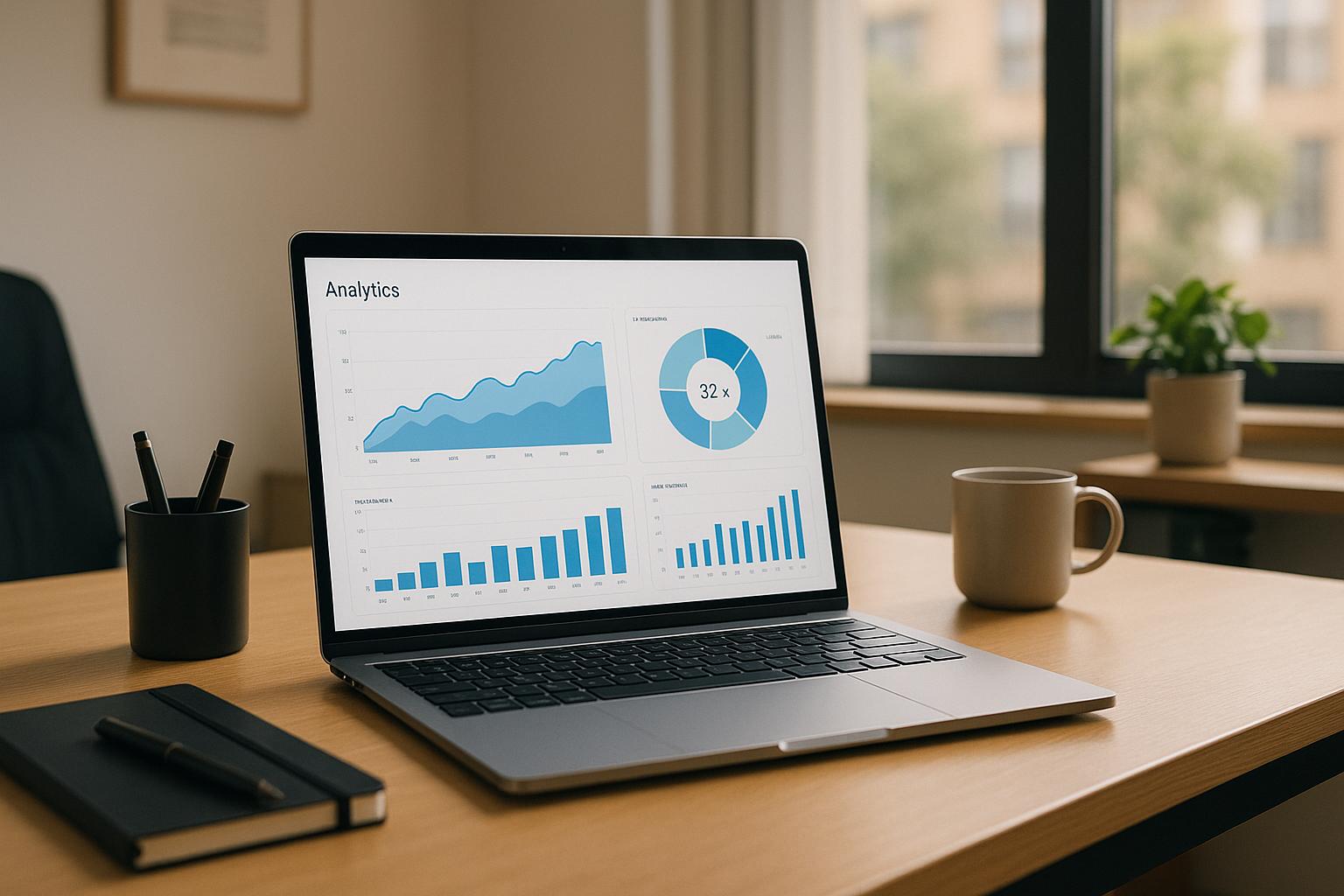B2B marketers face a common challenge: creating great content is only half the battle - getting it in front of the right audience is the real hurdle. This article highlights 10 platforms designed to help you distribute your content effectively, boost visibility, and generate high-quality leads. From LinkedIn's professional network to NetLine's targeted lead generation, each platform offers unique strengths.
Key Highlights:
- LinkedIn: Best for professional networking; generates leads 277% better than Facebook or Twitter.
- NetLine: Offers a pay-per-qualified-lead model with advanced targeting for over 125M monthly visitors.
- ViB Syndication: Focuses on tech professionals with zero-party data for precise targeting.
- Outbrain & Taboola: Leaders in native advertising with extensive publisher networks.
- Demandbase: AI-driven account-based marketing with intent data for high-value accounts.
- Quora: Engages decision-makers through Q&A content and Bombora-powered targeting.
- Medium for Business: Builds authority with detailed, research-focused content.
- Headley Media: Specializes in global B2B lead generation for tech companies.
- Marketing Funnels Directory: Guides marketers in optimizing funnels and nurturing leads.
Quick Comparison
| Platform | Best For | Lead Model | Analytics Features | Pricing Model |
|---|---|---|---|---|
| Professional networking | Sponsored content, ads | Campaign insights, CTR tracking | Starts at $10/day | |
| NetLine | Targeted lead generation | Pay-per-lead | Real-time reporting | Cost-per-lead |
| ViB Syndication | Tech professional engagement | Pay-per-download | Pipeline analytics | Pay-per-lead |
| Outbrain | Native advertising | CPC | Engagement metrics | CPC-based |
| Taboola | Native ads on publishers | CPM | Conversion tracking | CPM-based |
| Demandbase | Account-based marketing | AI-driven targeting | Advanced ABM insights | Enterprise pricing |
| Quora | Q&A-based engagement | Quora Ads, organic reach | Audience insights, CTR tracking | Ads available |
| Medium | Authority-building content | Organic reach | Reader engagement tracking | Subscription-based |
| Headley Media | B2B tech lead generation | Fixed cost-per-lead | Lead validation tools | Custom pricing |
| Marketing Funnels | Funnel optimization guidance | Nurtured leads | Funnel performance tracking | Resource-based access |
Each platform is tailored to specific marketing goals, from lead generation to thought leadership. To maximize results, consider combining multiple platforms and tracking performance to refine your strategy over time.
What's Different About Content Distribution For B2B? - Marketing and Advertising Guru
1. NetLine
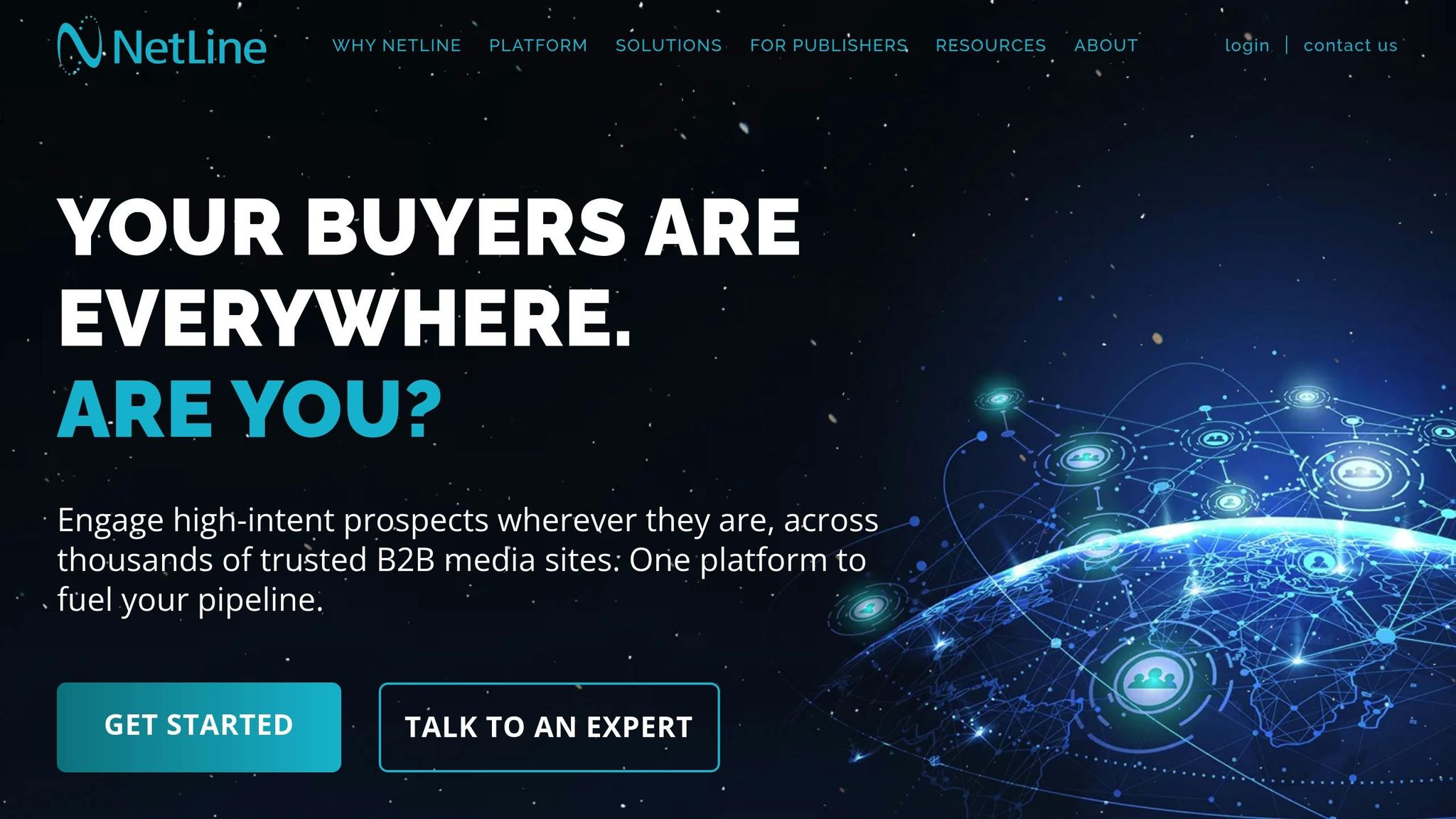
NetLine is a powerful platform designed to connect marketers with targeted business audiences. Recognized as a G2 Leader in the Lead Capture category for an impressive 30 consecutive quarters, it’s clear that this platform has earned its place as a trusted tool in the industry. Let’s dive into how NetLine’s targeting features and lead generation capabilities contribute to these results.
Audience Targeting Capabilities
NetLine’s targeting technology is nothing short of impressive, offering 37 million filtering options to help marketers zero in on their ideal customer profiles. Its proprietary AudienceTarget technology takes targeting a step further by not just focusing on basic demographics but also matching content with buyers who are actively seeking relevant information. This ensures your content reaches people who are already engaged and interested.
For those employing ABM (Account-Based Marketing) strategies, NetLine combines personas, company filters, and intent data to create highly specific audience segments. This level of precision means your content lands in front of the prospects who are most likely to convert.
NetLine also operates on a pay-per-qualified-lead model, so you only pay for leads who download your content and meet your pre-set criteria. This cost-efficient approach is especially appealing for marketers working within tight budgets.
Lead Generation Effectiveness
NetLine’s results speak for themselves. The platform reaches over 125 million unique visitors monthly and processes more than 700,000 leads each month, spanning 300 different industries. These leads are intent-driven, meaning they’ve shown genuine interest in your offerings by engaging with your content.
Customer satisfaction is another strong indicator of NetLine’s success. The platform boasts a 94% renewal rate among its Full-Service clients, highlighting the consistent quality of its leads and results. Independent evaluations back this up, with NetLine earning top marks - 5/5 - for Customer Focus, Price vs. Value, and Project Success.
"We are honored to be recognized as a top B2B lead generation vendor", said Robert Alvin, CEO of NetLine Corporation.
Analytics and Reporting Features
NetLine equips marketers with real-time dynamic reporting that updates every 30 minutes after a content registration, providing immediate feedback on campaign performance. The platform’s interactive visualization tools, such as dynamic pivot tables, heatmaps, and custom lead filters, make it easy to interpret data and identify trends.
The reporting suite offers a wealth of insights, including company details, lead demographics, custom question responses, and content performance summaries. With this data, you can adjust your campaigns on the fly and make smarter, data-driven decisions about how to distribute your content.
"NetLine delivers real-time, customizable reports that empower immediate, data-driven decisions. We're thrilled with the results. NetLine has truly been a win." - Danielle Amato, Segment Marketing Leader, Mercer.
Content Distribution Reach and Scalability
NetLine’s content distribution network is vast, spanning over 15,000 web and publisher properties, ensuring your content reaches potential buyers at multiple points in their research journey. Its programmatic lead generation capabilities allow marketers to automate and fine-tune campaigns in real time, making it an ideal solution for businesses of all sizes.
Seamless integration with MAP and CRM systems further enhances its usability. This means you can quickly prioritize and follow up on qualified leads without overhauling your existing workflows. NetLine’s ability to fit seamlessly into your marketing technology stack makes it a practical choice for streamlining lead generation efforts.
2. ViB Syndication
ViB Syndication takes a unique, community-driven approach to B2B content distribution, specifically targeting tech professionals who have opted in to discover new solutions. Unlike traditional advertising platforms that aim to reach a broad audience, ViB connects your content directly with engaged end-users who are actively interested in products and services that align with their business needs. This community-focused strategy sets the stage for precise audience targeting, as outlined below.
Audience Targeting Capabilities
ViB's platform is built on advanced segmentation, ensuring your content reaches the right audience. By leveraging detailed tech profiles, ViB can target prospects based on factors like job title, job level, location, company size, revenue, industries, and even specific ABM (Account-Based Marketing) lists. Using both firmographic and psychographic insights, ViB ensures your message reaches decision-makers whose needs align with your offerings.
What sets ViB apart is its use of zero-party data - information that tech professionals voluntarily share - ensuring you engage with an audience that has explicitly expressed interest in receiving relevant content. This approach eliminates guesswork and delivers your message to individuals who are genuinely interested in what you offer.
Lead Generation Effectiveness
ViB Syndication has a proven track record of delivering results. For example, Google's Siemplify campaign saw a 4x increase in pipeline generation compared to previous providers after using ViB Syndication for over two years. Additionally, Google maintained a 100% lead acceptance rate for over a year and achieved a 50% higher conversion rate with ViB. Nearly half of the leads generated through ViB Syndication converted into actual customers.
ViB's pay-per-qualified-download model ensures you only pay for leads who actively engage with your content and meet your qualification criteria.
"ViB will get you quick results with immediate opportunities...we haven't experienced any audience exhaustion with ViB and we haven't rejected a single lead in more than a year." - Mike Hardwicke, VP of Demand Generation, Google
Analytics and Reporting Features
To help marketers refine their strategies, ViB provides detailed, real-time analytics. These insights offer a clear view of engagement and lead generation metrics, enabling continuous optimization. With this data, you can make informed decisions and fine-tune your campaigns for better performance.
Content Distribution Reach and Scalability
ViB prioritizes quality over quantity when it comes to content distribution. The platform ensures your content reaches tech professionals who have actively opted in to explore new solutions.
ViB's scalability is evident in success stories like Abnormal Security, which generates 1,000–1,500 leads quarterly and drives over $800,000 in monthly revenue through ViB Content Syndication. This steady flow of high-quality leads supports ongoing demand generation and adapts to the growth needs of businesses.
Moreover, ViB's community-driven model helps avoid audience fatigue by continuously attracting new tech professionals. This ensures a consistent stream of high-quality leads while maintaining a focused and effective B2B content strategy.
3. LinkedIn
LinkedIn stands out as the go-to professional network for B2B content distribution, connecting marketers with 1 billion professionals across over 200 countries and territories. Among these users are 65+ million decision-makers from 68 million companies spanning various industries. What makes LinkedIn so effective for B2B marketing? Its professional environment. In fact, 4 out of 5 LinkedIn members influence business decisions in some capacity. This combination of a focused audience and precise targeting makes LinkedIn a powerful tool for generating high-quality leads.
Audience Targeting Capabilities
LinkedIn's targeting capabilities are built on its vast reservoir of first-party data. Marketers can fine-tune their campaigns using filters such as company size, industry, job title, and seniority through its Company and Contact Targeting options.
The Matched Audiences feature takes this a step further, allowing businesses to integrate their own customer or lead data with LinkedIn’s database. This enables advanced targeting through options like website retargeting, account targeting, and contact targeting. With tools like Audience Insights and Predictive Audiences, marketers can zero in on high-intent prospects while gaining a deeper understanding of demographic data.
LinkedIn also collaborates with Customer Data Platforms (CDPs) and partners like HubSpot, 6sense, Demandbase, and G2. These integrations enhance targeting by incorporating technographic and intent-based data, providing marketers with unparalleled precision.
"LinkedIn really is the best platform for B2B audience targeting, due to its professional nature and robust user data. It allows advertisers to reach a highly engaged and relevant audience based on job titles, industries, company sizes and a lot more. This ensures that their ads are seen by decision-makers and professionals in their target market." – Crystal King, Social Media Professor at HubSpot
Lead Generation Effectiveness
LinkedIn dominates B2B lead generation, with 89% of B2B marketers relying on the platform for this purpose. Its audience is 6x more likely to convert compared to other platforms, and LinkedIn boasts 2x higher overall conversion rates.
The platform’s success in generating quality leads is reflected in the fact that 62% of B2B marketers report LinkedIn as a top source for business leads. Moreover, 50% of B2B buyers turn to LinkedIn during their purchasing journey, making it a vital touchpoint. LinkedIn users also show higher engagement, being four times more likely to visit your website compared to Facebook users.
With a visitor-to-lead conversion rate of 2.74%, LinkedIn outperforms Facebook and Twitter by 277%. This success stems from its professional context, where users are already in a business-focused mindset.
Analytics and Reporting Features
LinkedIn’s analytics tools, including Campaign Manager and Page Analytics, provide marketers with detailed performance insights. These tools track everything from ad delivery to conversion rates, offering a comprehensive view of campaign effectiveness. Here's a snapshot of LinkedIn's reporting capabilities:
| Metric Type | Description |
|---|---|
| Performance | Tracks key metrics like spend, clicks, and average click-through rate (CTR). |
| Delivery | Measures how many people saw your ads and how often they were displayed. |
| Conversions | Provides data on conversion rates and cost per conversion. |
| LinkedIn Audience Network | Evaluates ad performance beyond LinkedIn itself. |
| Video | Analyzes video ad performance metrics. |
| Budget and Bid | Summarizes daily budgets, total spend, and average daily costs. |
In addition to campaign metrics, LinkedIn offers tools for tracking employee engagement and analyzing competitors. The Content Suggestions tool further aids marketers by identifying relevant topics and articles tailored to their audience.
Content Distribution Reach and Scalability
LinkedIn is designed to scale content distribution across the entire B2B buyer journey. Its LinkedIn Audience Network extends ad reach beyond the platform, maintaining a professional context while broadening visibility. Companies posting weekly updates see 2x more engagement, and video content can boost engagement by 5x.
The platform’s scalability allows marketers to target different buyer personas - such as Initiators, Influencers, End Users, Gatekeepers, and Decision-Makers - using tailored content strategies. LinkedIn’s ad tools make it possible to guide prospects through every stage of the buyer journey, from awareness to final conversion.
4. Outbrain
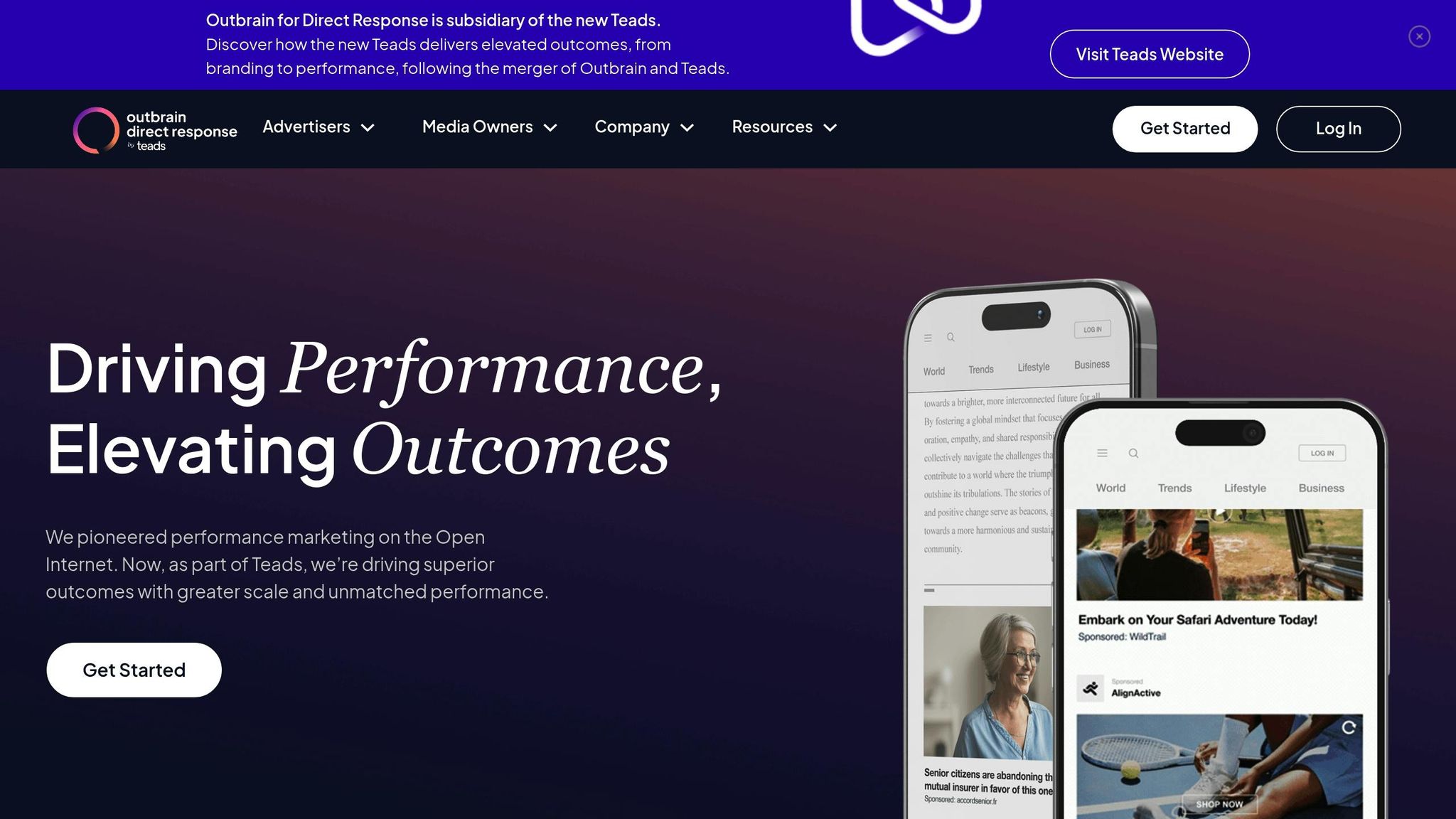
Outbrain stands out as a major player in native advertising, seamlessly integrating promotional content with editorial material on high-quality websites. This method makes ads feel more natural and less intrusive, which is crucial for earning professional trust. The platform is particularly geared toward content distribution, making it an excellent choice for sharing materials like whitepapers, case studies, and blog posts that foster B2B engagement. By doing so, it supports precise targeting, generates leads, and provides actionable performance insights.
Audience Targeting Capabilities
Outbrain’s audience targeting tools are designed to connect B2B marketers with key decision-makers. Its Interest Targeting uses the Outbrain Interest Graph to identify users based on their browsing and content consumption habits. Meanwhile, Attribute Targeting taps into third-party data to focus on demographics, intent, and professional attributes. The platform also offers Custom Audiences for retargeting users who’ve previously interacted with content on its network, as well as Lookalike Audiences to find new users similar to past converters.
For B2B campaigns, you can refine targeting by focusing on specific segments like company size, revenue, industry, seniority, and decision-making roles. A great example of this is Clix Marketing's success in leveraging these tools. While fine-tuning your targeting, the Reach Estimator can help you gauge the potential audience size.
"The key to a successful Outbrain campaign is delivering the right ads at the optimal time to the relevant audiences." - Dana Wicnudel
Lead Generation Effectiveness
Outbrain’s native advertising thrives in B2B lead generation by focusing on content-first engagement. Instead of pushing direct sales, it emphasizes high-value content like blog posts, whitepapers, and e-books that naturally attract leads. Given that B2B buying decisions often involve input from six to seven stakeholders, this strategy ensures broader engagement across multiple decision-makers. Additionally, Outbrain’s retargeting tools allow advertisers to re-engage users who previously interacted with their content, while its Interest Targeting helps connect with audiences based on authentic interests.
Analytics and Reporting Features
Outbrain equips marketers with advanced analytics to fine-tune campaigns. The platform provides real-time tracking for metrics such as impressions, clicks, conversions, and ROI. Its analytics dashboard enables you to monitor performance by traffic source, making it easier to weed out underperforming publisher sites. With detailed engagement data, marketers can continuously conduct A/B testing to improve headlines, visuals, and content formats for better outcomes. Outbrain’s algorithm also analyzes user behavior to recommend content optimizations, and tools like Admetrics can be integrated for predictive analysis powered by machine learning.
Content Distribution Reach and Scalability
Outbrain’s vast premium network, combined with its CPC model, allows for scalable content distribution. Video ads are particularly effective, boosting lead generation by up to 80%, while 60% of traffic comes from mobile devices. However, marketers should note that using specialized targeting options may incur additional fees for third-party data on top of the base CPC. Overall, Outbrain’s content-focused strategy helps expand the reach of valuable materials, capturing leads that might otherwise remain untapped through organic methods alone.
5. Taboola
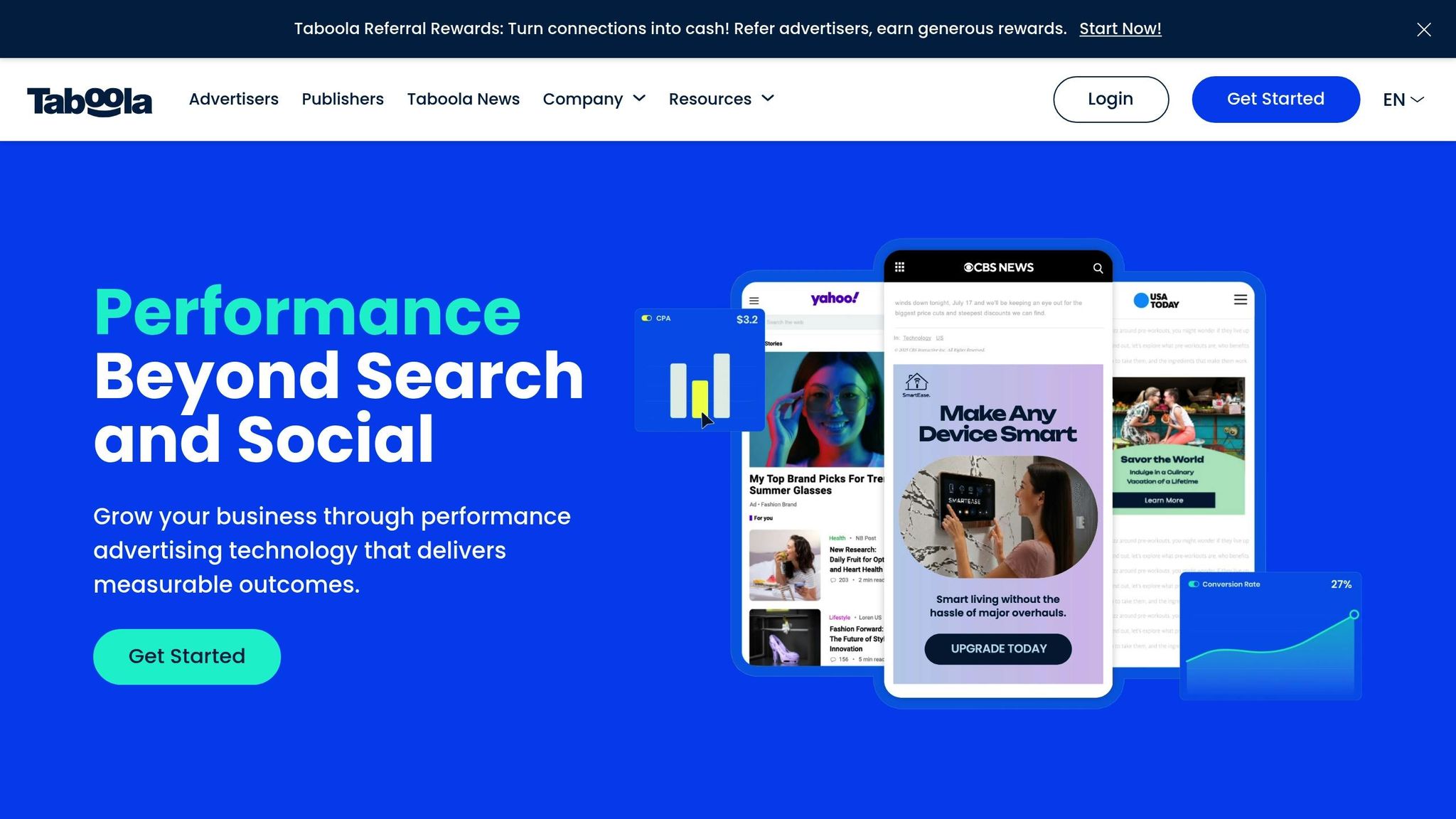
Taboola is a standout platform for B2B lead generation, leveraging native advertising to seamlessly integrate promotional content with editorial material on premium publisher websites. This approach makes marketing messages feel more organic and less intrusive - key for earning trust among professional audiences. Taboola excels at distributing content like case studies, industry reports, and thought leadership pieces, driving valuable engagement from decision-makers.
Audience Targeting Capabilities
Taboola combines traditional demographic targeting with advanced, AI-driven audience identification. It offers standard options like location, device type, operating system, and connection type, allowing for precise targeting. What sets Taboola apart is its Predictive Audiences feature. This tool uses machine learning to identify users based on their behaviors, not just demographics.
With Predictive Audiences, custom audiences are created based on specific actions - like completed leads or purchases. Taboola's AI then finds similar users across its network. This method has delivered impressive outcomes, including up to a 270% increase in conversions. Since its launch in February, advertiser confidence in this feature has grown, with weekly ad spend tripling.
For B2B marketers, this means campaigns can be tailored to balance audience size with performance goals. Taboola also integrates your first-party data with its AI tools, ensuring a privacy-conscious yet effective way to reach high-converting users.
Lead Generation Effectiveness
Native ads on Taboola generate a 53% higher click-through rate (CTR) compared to traditional display ads. This effectiveness is evident in campaigns like Boilers Online, which achieved 1,200 monthly visits and a 25% conversion rate.
Boilers Online, a brand created by Help-link, optimized its website for lead conversions using Taboola. After refining their campaign, they saw 1,200 visits per month, leading to 60 completed surveys with a 25% conversion rate. These exclusive, inbound leads were delivered at a cost that worked for the client. Once the strategy proved successful, the budget was scaled up to generate even more leads.
"Predictive Audiences have proven instrumental in refining our targeting strategy and maximizing our marketing efficiency. It's a must-have for any team looking to elevate their campaign performance." - Ajay Bhatia, Marketing Manager for The Motley Fool
Analytics and Reporting Features
Taboola offers a robust analytics suite that provides real-time insights into campaign performance. Metrics like impressions, clicks, conversions, and return on ad spend (ROAS) are tracked to help marketers make immediate adjustments and optimize budgets effectively.
These tools also include audience insights, which reveal details about who is engaging with your ads, such as demographics, location, and device usage. Conversion tracking follows the entire customer journey, from the first impression to the final action, while content performance metrics identify which materials resonate most with your audience.
Custom reporting options let marketers tailor reports to meet specific business needs. Additionally, Taboola integrates with platforms like Admetrics to unify analytics and provide detailed performance reports. These insights are invaluable for scaling campaigns and maximizing results.
Content Distribution Reach and Scalability
Taboola's extensive network of top-tier publisher websites ensures B2B marketers can connect with engaged professional audiences where they’re already consuming content. The platform’s flexibility accommodates campaigns of all sizes, whether for small businesses or large enterprises.
Native ads on mobile devices perform particularly well, delivering twice the CTR of desktop ads. This is especially important as B2B decision-makers increasingly rely on mobile devices during their research.
Taboola’s native advertising model is cost-effective, delivering higher click-through and conversion rates compared to traditional display ads. To maximize performance, marketers should separate campaigns by device type and adjust bidding strategies accordingly. Splitting iOS and Android campaigns can also help optimize conversion values.
"The ease of implementation and rapid scalability allowed us to see results almost immediately. Taboola has become a key partner in helping us reach the right users at the right time, all while maximizing efficiency and growth." - Marketing team at QuinStreet
6. Headley Media
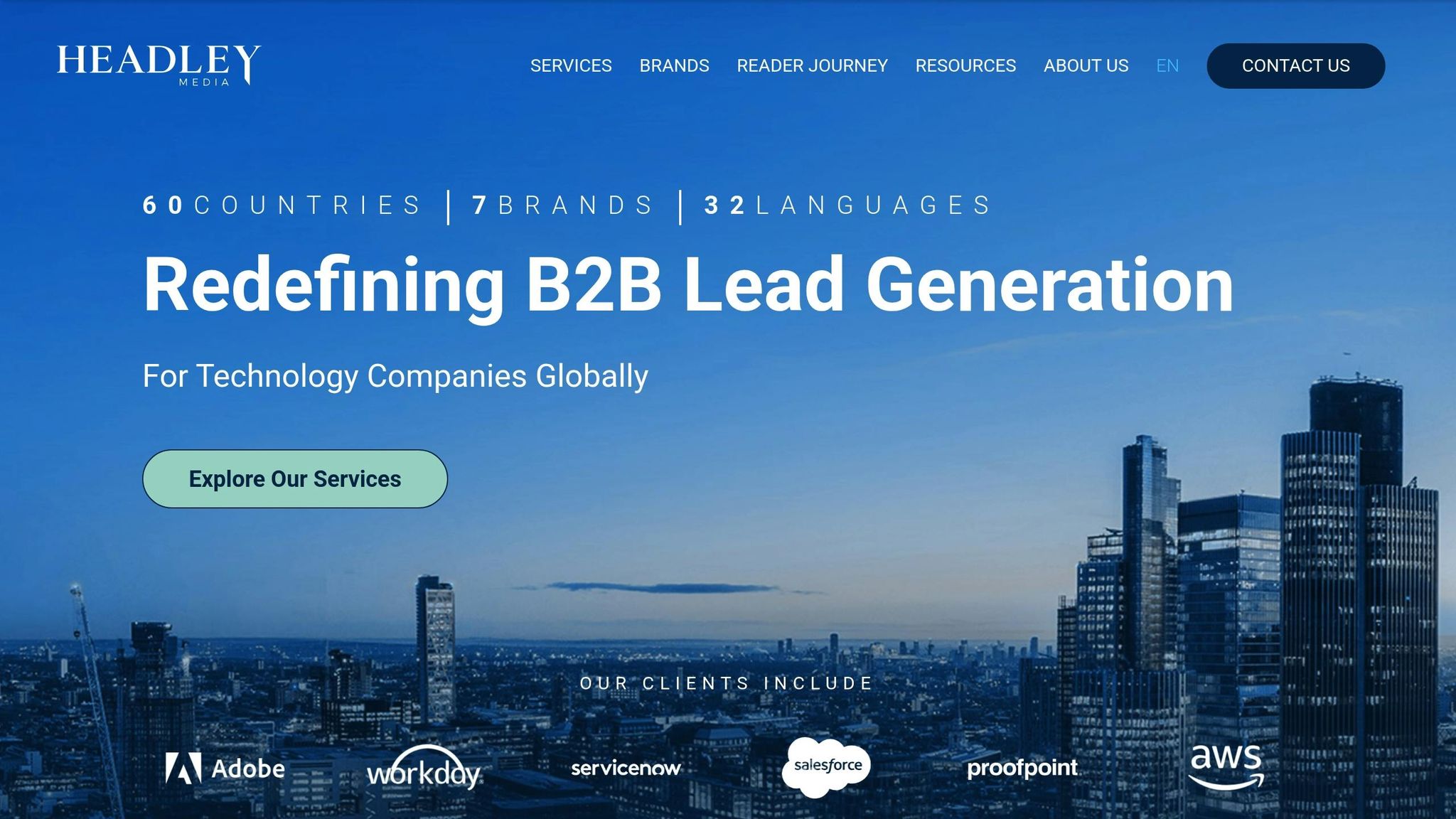
Headley Media is a B2B content distribution platform designed for technology companies. It operates an extensive network of 300 websites across 60 countries and 32 languages, making it a global player in the industry.
One of its standout features is a fixed cost-per-lead model, which helps B2B marketers plan campaigns with confidence. This pricing approach eliminates much of the uncertainty, allowing businesses to set clear ROI expectations and stick to their budgets.
Audience Targeting Capabilities
Headley Media’s global reach is matched by its precision in targeting IT and technology decision-makers. Through its Headley Display campaigns, the platform places ads where B2B audiences are already engaged. It refines targeting using criteria like job titles, regions, company sizes, industries, intent keywords, and even specific technology brands.
For example, Nasuni partnered with Headley Media to connect with IT decision-makers across EMEA using the IT Corporate portfolio. The collaboration consistently delivered qualified leads while meeting guaranteed lead volumes.
Lead Generation Effectiveness
Headley Media doesn’t just stop at precise targeting - it also ensures high-quality lead generation. By combining AI-driven tools with manual data validation, it maintains a high standard for lead accuracy. The fixed cost-per-lead model further supports marketers by offering predictable budgeting and guaranteed lead volumes.
Proofpoint, a long-term partner, has seen success using Headley Media’s IT Corporate and Cybersecurity Corporate brands for lead generation campaigns.
"Headley Media has been a valued partner for us over several years, delivering successful lead generation campaigns across their IT Corporate and Cybersecurity Corporate brands... The ROI from our campaigns has exceeded our expectations, and we highly recommend Headley Media's services."
– Helen Gillbe, EMEA Demand Generation Director, Proofpoint
Similarly, Malwarebytes has utilized Headley Media’s localized content libraries to run targeted campaigns. By tailoring questions for each initiative, they’ve equipped their sales teams with actionable insights for more effective follow-ups.
Analytics and Reporting Features
Headley Media employs a custom machine learning platform to optimize campaigns and avoid wasting resources on ineffective inventory. This, combined with expert oversight, ensures swift and transparent proposals.
"Headley Media is a valuable partner to us, providing our clients with access to the IT, Finance and HR Audiences. Their ability to provide fast, clear and concise lead generation proposals allows us to relay key information back to our clients in a timely manner as well as delivering campaigns which see high conversion rates, making them a continuously strong partner."
– Ian Sargeant, Senior Account Director Merkle B2B EMEA, London
Content Distribution Reach and Scalability
Thanks to its large network of syndication platforms, Headley Media offers global reach for B2B technology companies. It supports both regional and international campaigns, ensuring consistent quality and precision in targeting. This infrastructure allows businesses to scale their efforts without compromising on results.
"The relationship and trust we have built over the years with Headley Media has helped us deliver successful B2B lead generation and content syndication campaigns relying on their extensive audience network and robust targeting capabilities."
– Niccolo Folchi-Vici, Account Director, Wavemaker, London
sbb-itb-a84ebc4
7. Demandbase
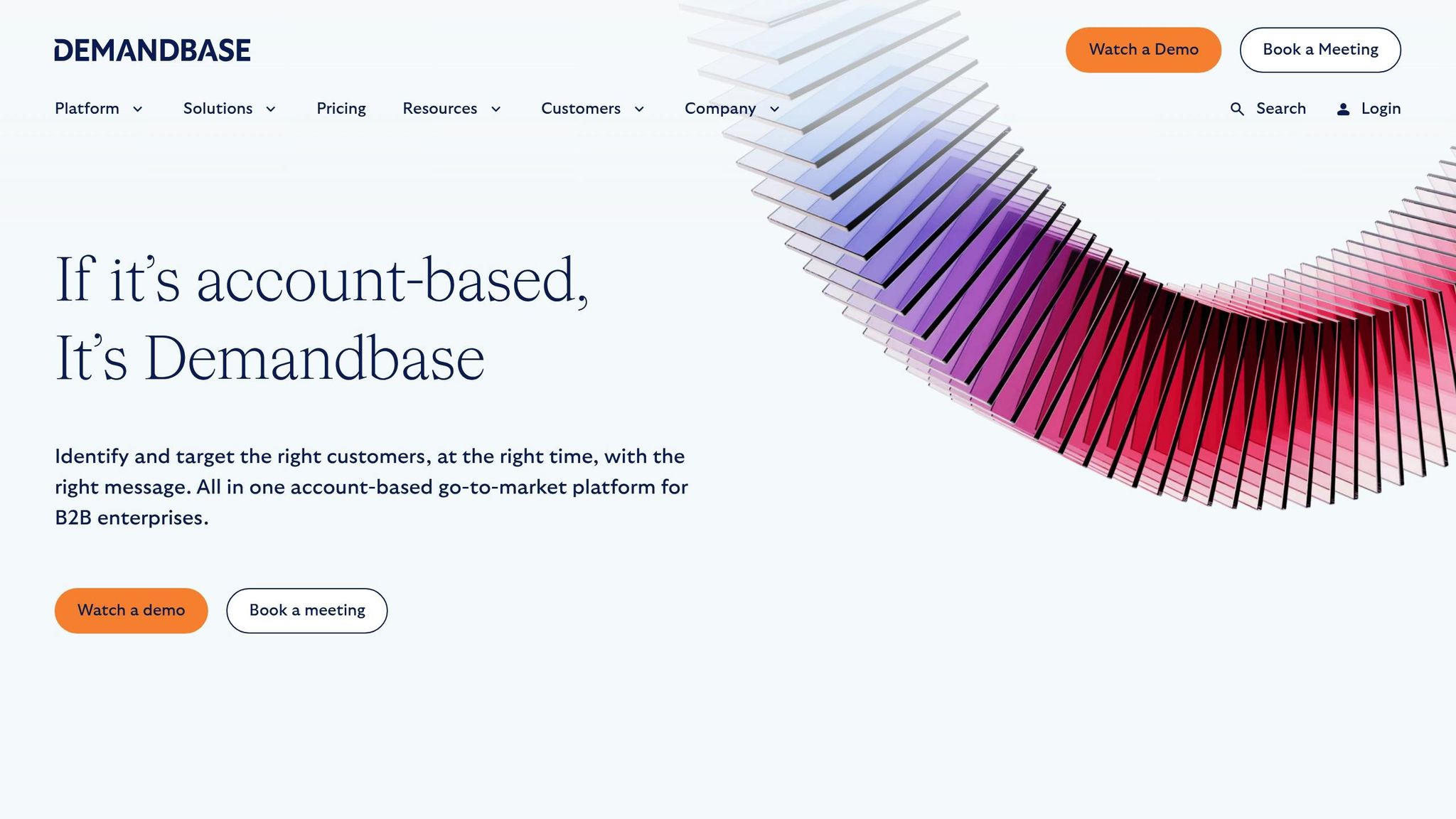
Demandbase is an AI-driven account-based marketing platform designed to help B2B companies pinpoint, target, and engage with high-value accounts. By processing over a trillion intent signals every month, it focuses on precision strategies like zero-waste advertising rather than broad, less-targeted approaches. Below, we’ll explore how Demandbase delivers results in audience targeting, lead generation, analytics, and scalability.
"Our customers have seen the power of zero-waste advertising, driving a new level of relevance from their advertising strategies." - Chris Golec, founder and CEO of Demandbase
Audience Targeting Capabilities
Demandbase excels in advanced audience targeting, ensuring marketers reach the most relevant accounts. One of its standout features is technology-based targeting, which allows businesses to connect with companies based on the specific tools and technologies they use. This is especially useful for B2B tech firms aiming to engage prospects using complementary or competing solutions.
The platform also emphasizes people-based advertising, targeting individuals within accounts based on job roles, functions, and buying group memberships. By blending these attributes, marketers can create detailed personas for sharper targeting.
Demandbase combines AI-powered account selection with custom CRM data, buyer personas, behavior patterns, intent signals, and sales activity to build hyper-targeted audiences. Advertisers using its Company-Targeted Advertising see engagement rates increase by 2–3 times compared to traditional methods. Additionally, integration with Adobe Real-Time CDP B2B Edition enhances segmentation and precision targeting.
Lead Generation Effectiveness
Demandbase prioritizes quality over quantity when it comes to leads. Using AI predictive scoring, it ranks accounts by their likelihood of conversion, enabling sales and marketing teams to focus their attention where it matters most.
The platform’s display advertising shows a strong pipeline generation impact, with a correlation of 0.69, and can influence bottom-funnel metrics like opportunities and pipeline within a week. Paid search, on the other hand, demonstrates immediate results, with impressions creating an impact in just one day.
For the best results, Demandbase suggests pairing display advertising with paid social, as this combination amplifies their strengths and achieves a synergy correlation of 0.66. Its AI-powered workflows further streamline processes by automating tasks, surfacing insights, and recommending actions to move accounts through the pipeline more efficiently.
Analytics and Reporting Features
Demandbase offers a robust analytics suite through its Campaigns dashboard, which provides insights into key metrics such as impressions, click-through rates, and account engagement. Marketers can track and optimize campaigns in real time, thanks to detailed account behavior data.
The platform’s reporting system includes specialized tabs for deeper analysis. For example, the Campaigns tab highlights metrics like ad spend, account reach, and impressions, while the Domains tab focuses on performance metrics for specific accounts.
Here’s a snapshot of key performance benchmarks:
| Metric | Benchmark | Description |
|---|---|---|
| Accounts Reached | 70% or greater | Accounts served at least one impression |
| Accounts Visited | 40% | Accounts that visited your website |
| Interacted | 25–30% | Accounts meeting interaction benchmarks |
| Clicked | 20–25% | Accounts that clicked your ad |
| CTR | 0.05–0.07% | Click-through rate |
| Lifted | 25–45% | Increase in account engagement |
Demandbase also provides detailed reporting on job levels, functions, and known contacts, helping marketers identify which personas engage most with their campaigns. This granular data enables teams to fine-tune their targeting and messaging strategies.
Content Distribution Reach and Scalability
A key challenge for many B2B companies is the disconnect between sales and marketing teams. Demandbase addresses this by unifying both teams on a single platform, ensuring they work with the same data and insights. This alignment allows them to collaborate effectively on the same accounts, contacts, and buying groups.
"B2B sales and marketing teams have worked on separate platforms since, well, forever. It's no wonder their efforts often lead to inefficiency and misalignment. With Demandbase One™, marketers and sellers are on the same platform, using shared data and AI insights to coordinate on the same accounts, contacts, and buying groups." - Umberto Milletti, Chief R&D Officer, Demandbase
Demandbase’s scalability lies in its ability to automate account identification and engagement while maintaining precision. Marketers can begin with paid search for quick lead capture, build awareness with paid social, and close deals with display advertising. This multi-channel strategy ensures consistent lead management and allows companies to scale their account-based marketing efforts effectively.
8. Quora
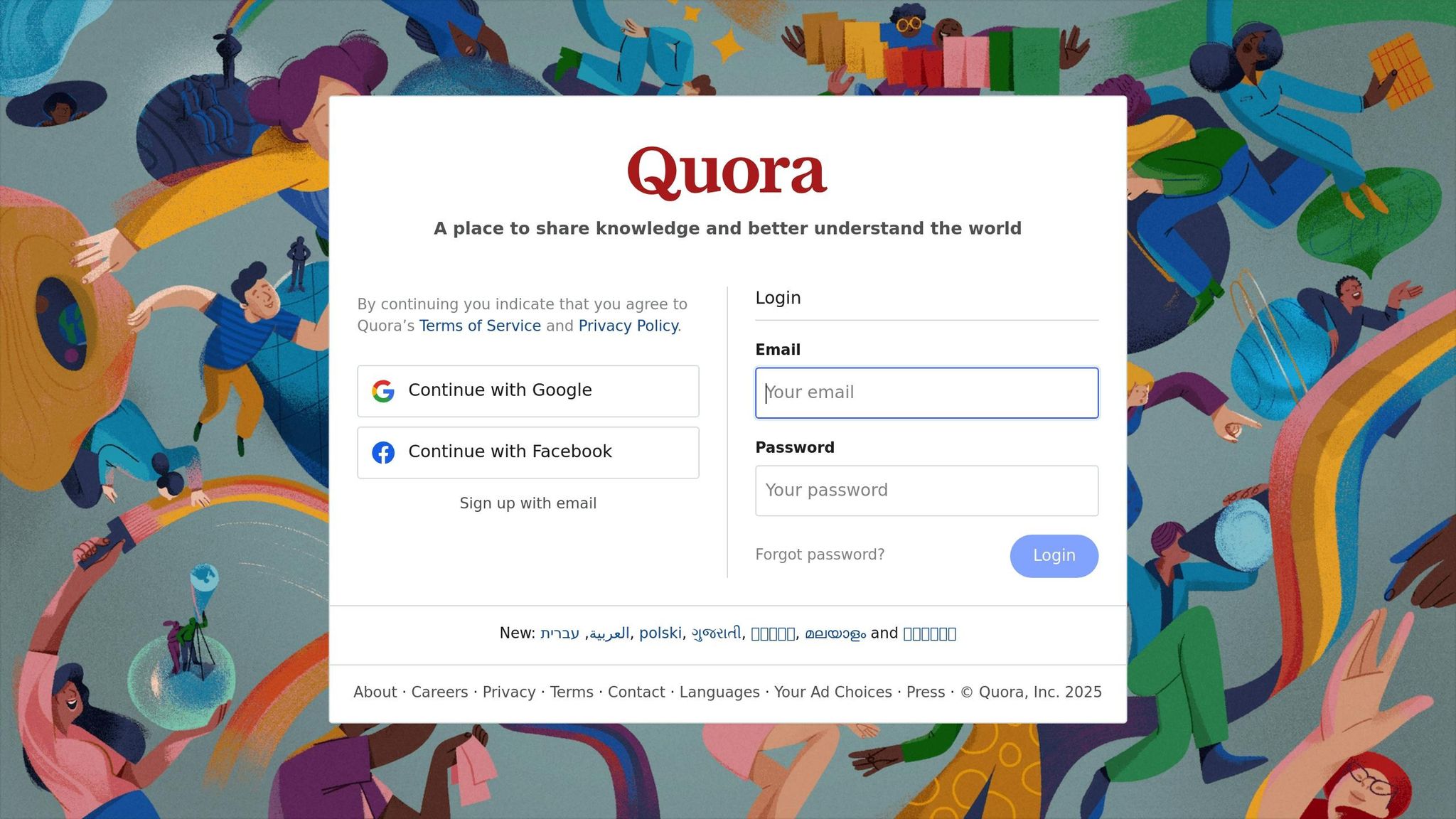
Quora connects B2B marketers to a massive audience of over 400 million monthly visitors, many of whom are actively seeking professional insights. With 65% of its audience holding college degrees and 54% earning household incomes above $100,000, Quora provides access to an educated and affluent user base. It's no surprise that 60% of advertisers on the platform are B2B companies, making it a go-to space for reaching decision-makers in a natural and engaging way.
Audience Targeting Capabilities
Quora's targeting features have been significantly bolstered through its partnership with Bombora, a collaboration that enhances account-based marketing (ABM) efforts. This partnership introduces over 450 B2B audience segments to Quora's advertising toolkit.
"This partnership represents a significant milestone in Quora's advertising capabilities and reinforces our position in the B2B marketing landscape."
- Vinay Pandey, Quora Chief Revenue Officer
Advertisers can refine their campaigns using filters like job function, seniority, company size, and industry. On top of that, Bombora's data enables advanced targeting options, such as audience segments, keyword targeting, and contextual question or topic targeting. For example, a CEO researching startup business models might see a cybersecurity ad tailored to their interests, while a Senior VP in technology browsing a question about hobbies could encounter an ad for enterprise risk management software.
"Our partnership enables advertisers to reach Quora's highly engaged user base - delivering a new level of strategic targeting and optimal campaign performance."
- Mike Burton, Bombora Co-Founder & Strategic Partnerships EVP
Lead Generation Effectiveness
Quora is particularly effective for brands looking to build trust with an audience that’s already seeking answers. Many B2B companies, like Thrillax, have reported a noticeable increase in lead generation by leveraging Quora Ads to connect with decision-makers in their target industries.
Analytics and Reporting Features
Beyond advertising metrics, Quora shines in tracking organic engagement. Marketers can monitor answer views, upvotes, shares, and profile visits to gauge how their content resonates. Its strong Google search rankings amplify the reach of answers, while conversion tracking and detailed audience insights help fine-tune paid campaigns. These features not only improve ad performance but also support broader content strategies.
Content Distribution Reach and Scalability
Quora’s influence goes beyond its registered users, reaching over 300 million monthly visitors who come to the platform to research and learn. Marketers can expand their efforts by answering relevant questions, creating Quora Spaces, or promoting high-performing answers. For instance, Asana co-founder Justin Rosenstein’s answer on productivity has amassed over 474,000 views, showcasing the platform's potential to drive sustained traffic. Additionally, quality answers often rank well on Google, continuing to attract attention long after they’re posted.
"Quora is the boardroom where your next client is unknowingly taking notes. If you're not there, you're letting your competitors seal the deal while you're still cold-calling."
- Eva OnlineYouGrow, Small Business Expert at OnlineYouGrow.com
9. Medium for Business
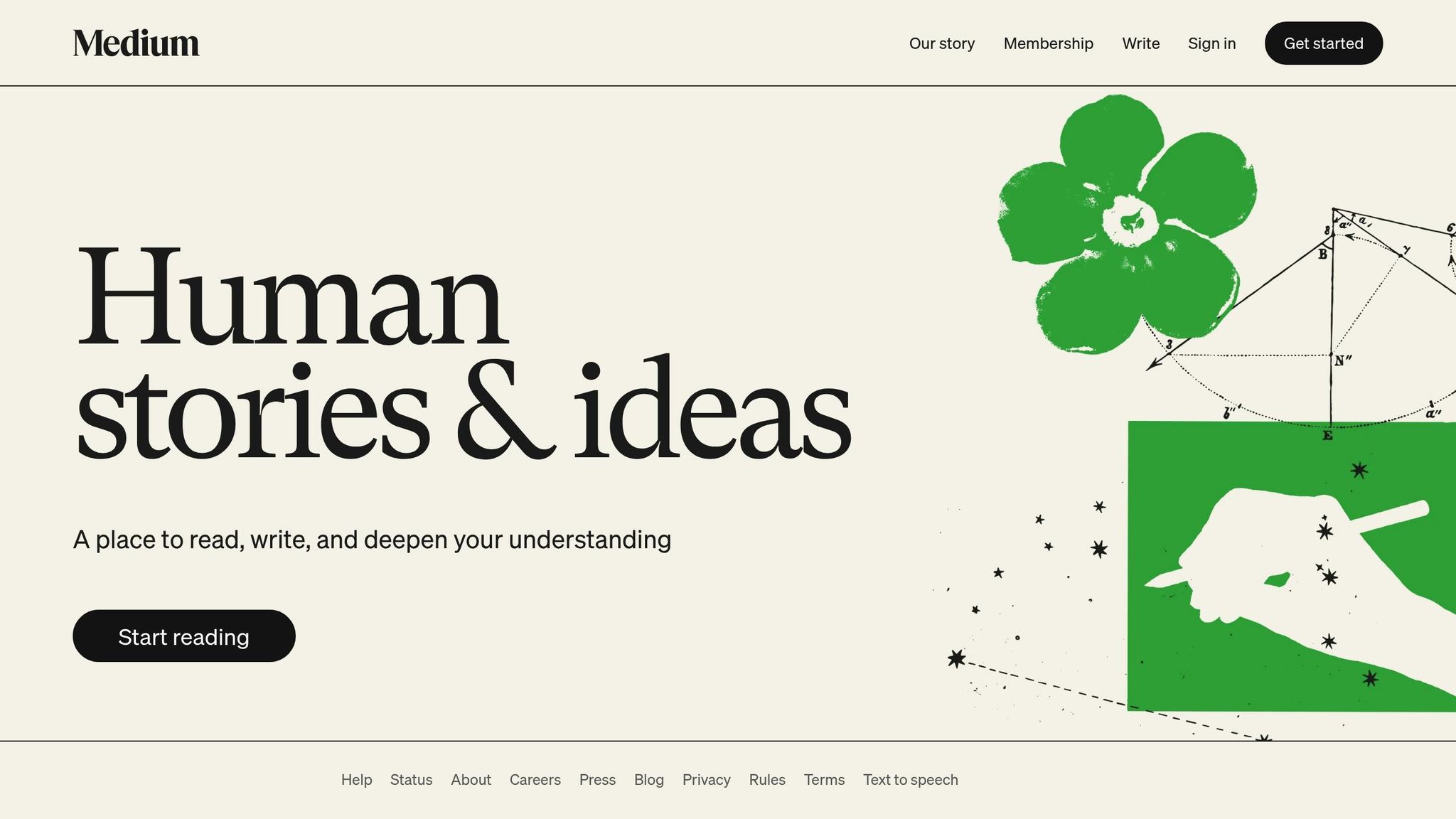
Medium for Business transforms the well-known publishing platform into a strategic tool for B2B content distribution, enabling companies to connect with professionals actively seeking industry insights. Unlike traditional advertising, Medium leverages its reputation for high-quality content to create a space where businesses can engage with decision-makers in a more genuine and impactful way.
What sets Medium apart is its ability to position B2B companies as trusted industry leaders. By publishing content that tackles real-world challenges faced by their audience, businesses naturally attract qualified leads who are already in the research phase. Considering that 70% of B2B marketers rely on content to generate leads, Medium provides an excellent opportunity for companies to build credibility and trust through expertise.
Lead Generation Effectiveness
Medium for Business doesn’t just boost brand authority - it also delivers tangible lead generation results. By addressing audience pain points with thoughtful and detailed content, businesses can establish a strong foundation of trust with potential clients. This approach aligns with the fact that content marketing costs 62% less than traditional methods while generating three times as many leads.
The key to success on Medium lies in creating content that resonates with your target audience at every stage of their buyer's journey. Companies that consistently provide actionable insights and in-depth research are more likely to see higher lead generation, as they cultivate the trust needed to turn readers into prospects.
Content Distribution Reach and Scalability
Medium goes beyond lead generation by offering robust content distribution capabilities. Its dual role as a publishing platform and discovery engine ensures that your content reaches a broad, engaged audience. Businesses can share their stories organically while benefiting from Medium's recommendation algorithms and partner publications. This organic reach makes it an appealing option for B2B companies aiming to scale their efforts without significantly increasing advertising budgets.
"Content is king, but distribution is queen." - Gary Vaynerchuk
What makes Medium even more effective is the long-lasting impact of evergreen content. Articles published on the platform often gain momentum over time, continuing to draw in new readers and generate leads months after they go live. This sustained visibility amplifies the value of your content, making Medium a smart choice for businesses looking to maximize their reach and impact.
10. Marketing Funnels Directory
The Marketing Funnels Directory stands out among B2B content distribution platforms by combining funnel strategy with a variety of distribution tools. This platform is tailored for B2B marketers looking for practical solutions to build effective funnels. It connects businesses with vendors, courses, and educational resources needed to create marketing funnels that deliver measurable outcomes.
What sets the Marketing Funnels Directory apart is its ability to address the entire B2B buyer journey. Since B2B marketing funnels must cater to multiple stakeholders - including executives, end-users, and other decision-makers - this platform provides tools to craft content that resonates with each audience segment.
Audience Targeting Capabilities
One of the directory's strengths is its ability to help B2B marketers develop precise buyer personas. Using detailed demographic, role-based, and behavioral data, marketers can create profiles that include specifics like location, education, job title, budget, team size, reporting structures, goals, and even preferred social media platforms. This granular approach is crucial for B2B marketers, where higher product costs and the need for stakeholder approval make targeting more complex than in B2C scenarios.
The platform also connects users with third-party data providers and account-based marketing (ABM) tools, enabling pinpoint accuracy in reaching target audiences. As Erin Hynes, Content Marketing Manager at StackAdapt, puts it: "With B2B advertising, the key is specificity". This level of precision forms the backbone of effective lead generation strategies.
Lead Generation Effectiveness
Generating traffic and leads remains a top challenge for 61% of marketers. The Marketing Funnels Directory addresses this by offering proven strategies to enhance lead generation efforts. This is especially relevant given that companies nurturing their leads see 50% more sales while reducing costs by 33%.
The directory also acknowledges that half of all qualified leads aren’t ready to buy immediately, and over 30% of B2B sales take one to three months to close. By providing businesses with structured funnel-building resources, the platform helps guide prospects through every stage of the buyer journey.
"A B2B marketing funnel is a series of steps designed to attract targeted leads to a website. Its main goal is to build brand awareness, increase loyalty, and convert potential customers into qualified hot leads."
– Ilse Van Rensburg, Marketing
Analytics and Reporting Features
Beyond targeting and lead generation, the directory integrates tools to monitor and improve funnel performance. For example, it highlights Funnelytics, a funnel mapping and analytics tool that helps marketers visualize, track, and optimize sales funnels.
This capability is critical, especially considering that 68% of companies admit they haven’t thoroughly evaluated their funnel performance. The directory bridges this gap by offering tools to analyze user flow, identify drop-off points, track conversion rates, and measure revenue generated at each funnel stage.
Funnelytics also enables marketers to forecast outcomes using real or assumed data, helping predict revenue potential and refine campaign strategies before launch. This data-driven approach equips businesses with the insights they need to fine-tune their content distribution efforts.
Content Distribution Reach and Scalability
The Marketing Funnels Directory provides businesses with the tools to scale their content distribution efforts effectively. Recognizing that digital ads are expected to account for nearly 50% of all B2B ad spending in 2024, the platform offers resources to help businesses capitalize on this trend.
Its scalability lies in its ability to support multiple content formats and distribution channels. Resources include guidance on using written, audio, and video content across blogs and social media platforms, as well as tips for implementing SEO strategies to boost organic traffic and enhance online visibility.
What makes the directory unique is its integrated approach to funnel optimization. Instead of focusing on a single channel, it offers resources for email marketing with automated sequences, paid advertising strategies, and retargeting. This multi-channel strategy ensures that businesses can expand their content reach while maintaining effectiveness across various touchpoints in the buyer journey.
Platform Comparison Table
When choosing a platform for B2B content distribution, it's essential to weigh key features, audience reach, lead models, analytics capabilities, and pricing. The table below provides a side-by-side comparison to help you make an informed decision.
| Platform | Key Features | Audience Reach | Lead Generation Model | Analytics & Reporting | Pricing Structure |
|---|---|---|---|---|---|
| NetLine | Performance-based syndication, industry targeting | 125+ million unique visitors; 700K leads/month across 300 industry sections | Cost-per-lead; guaranteed qualified leads | Comprehensive lead tracking; conversion analytics | Performance-based; cost-per-lead |
| ViB Syndication | High-tech B2B focus; community platform distribution | Millions-strong community platform | Pay-per-lead; 100% qualified leads guaranteed | Lead-to-opportunity tracking; pipeline analytics | Pay-per-lead only |
| Professional networking; thought leadership content | Extensive professional network | Lead generation ads; sponsored content | Native insights; campaign performance tracking | Ads from $10/day | |
| Outbrain | Native advertising; content recommendation | Global reach across a premium publisher network | Cost-per-click (CPC) model | Click-through rates; engagement metrics | CPC-based pricing |
| Taboola | Native display ads; direct campaign management | Substantial exposure across a publisher network | Cost-per-thousand (CPM) model | Impression tracking; engagement analytics | CPM-based pricing |
| Headley Media | Account-based marketing; targeted outreach | Focused B2B executive audience | Lead generation and appointment setting | Account engagement tracking | Custom pricing |
| Demandbase | Account-based marketing platform; intent data | Enterprise-focused targeting | Account-based lead scoring | Advanced ABM analytics; intent monitoring | Enterprise pricing |
| Quora | Question-and-answer platform; thought leadership | Hundreds of millions of monthly active users | Organic engagement; Quora Ads | Content performance; audience insights | Quora Ads available |
| Medium for Business | Professional publishing; thought leadership | Robust readership | Organic reach; brand awareness | Publication analytics; reader engagement | Subscription-based |
| Marketing Funnels Directory | Funnel strategy resources; vendor connections | B2B marketers and funnel builders | Lead nurturing through funnel optimization | Funnel performance tracking; conversion analytics | Resource-based access |
Key Insights from the Comparison
Each platform takes a different approach to B2B content distribution, offering unique strengths to meet diverse marketing goals. For example:
- LinkedIn stands out for professional networking and is highly effective at driving leads, outperforming others by 277% in lead generation effectiveness. It’s also a favorite among 85% of B2B marketers.
- NetLine delivers unmatched scale, reaching over 125 million unique visitors and generating 700,000 leads monthly.
- ViB Syndication prioritizes accountability with its pay-per-lead model, guaranteeing qualified leads.
- Platforms like Taboola and Outbrain rely on CPM and CPC models, respectively, for native advertising campaigns.
Analytics capabilities vary widely. Some platforms, like Demandbase, offer advanced tools such as intent monitoring and competitive benchmarking, while others provide more basic metrics. This distinction is crucial, as 47% of B2B marketers report challenges in measuring content performance, and 56% struggle with ROI attribution. Selecting a platform with robust analytics can make a significant difference in optimizing campaigns.
Ultimately, the right choice depends on your goals. Whether you prioritize professional networking (LinkedIn), large-scale lead generation (NetLine), or advanced account-based marketing (Demandbase), aligning platform capabilities with your strategy is key to success.
Conclusion
Picking the right combination of B2B content distribution platforms calls for a strategic approach that spans multiple channels. Sticking to just one platform won’t cut it, especially when buyers are constantly moving between different spaces online.
Each platform you choose plays a distinct role in your distribution strategy. LinkedIn stands out as the go-to for professional networking, while tools like NetLine and ViB Syndication excel at generating qualified leads through targeted outreach. Native advertising platforms, on the other hand, boost content visibility by placing it across top-tier publisher networks. Platforms like Quora and Medium are perfect for showcasing thought leadership and building credibility.
When these channels work together, their combined impact is far greater than what they could achieve individually. For instance, email campaigns remain a powerhouse, with an impressive 87% effectiveness rate for B2B marketers. Pairing email with social media can amplify results even further. The Marketing Funnels Directory demonstrates this by offering tools that help businesses fine-tune their customer journey from start to finish.
"Content is fire, and social media is gasoline." – Jay Baer
The numbers back up the importance of a multi-channel strategy: segmented email campaigns can lead to a staggering 760% increase in revenue, while nearly half (49%) of successful content marketers rely on paid social media for greater reach. To get the most out of your efforts, you’ll need to adapt your content to the strengths of each platform. For example, LinkedIn thrives on professional insights, social media shines with visual storytelling, and thought leadership platforms benefit from in-depth analysis.
The key to sustained success lies in consistently tracking performance and tweaking your platform mix based on engagement and conversion data. As the Content Marketing Institute puts it:
"Your content distribution strategy should be a living, breathing thing – something you're constantly analyzing and optimizing based on performance"
Since platforms and audience behaviors are always evolving, staying flexible and making data-driven adjustments is crucial. Keep an eye on what’s working, and don’t hesitate to pivot as needed to ensure your strategy stays effective over time.
FAQs
How do I choose the right B2B content distribution platform to meet my marketing goals?
How to Choose the Right B2B Content Distribution Platform
Start by defining your main marketing objectives. Are you aiming for lead generation, boosting brand awareness, or increasing audience engagement? Each platform has strengths in different areas. For instance, LinkedIn is a powerhouse for professional networking and generating B2B leads, while other platforms might shine when it comes to connecting with niche audiences or driving website traffic.
Next, think about where your target audience spends their time online. Knowing their preferences and behavior is key to picking a platform that delivers the most value for your content. Finally, make sure your choice aligns seamlessly with your broader content strategy. This ensures consistency and helps you get the most out of your efforts. By focusing on your goals and understanding your audience, you’ll set yourself up to choose a platform that delivers tangible results.
How do native advertising platforms like Outbrain and Taboola differ from LinkedIn for B2B marketing?
Native advertising platforms like Outbrain and Taboola specialize in placing sponsored content seamlessly within relevant editorial contexts across a variety of websites. These platforms are built to reach large audiences and target users based on their specific interests. This makes them an excellent choice for creating awareness and driving engagement on a broad scale.
In contrast, LinkedIn operates as a professional networking hub with highly targeted B2B marketing tools. Features like sponsored posts, InMail, and advanced targeting options - based on job titles, industries, and professional demographics - make LinkedIn a go-to platform for precise audience targeting, generating leads, and fostering professional connections.
While native advertising platforms shine in spreading content to a wide and varied audience, LinkedIn takes a more focused route, ideal for connecting with decision-makers and professionals in a business-oriented environment.
How do NetLine and ViB Syndication ensure the leads they generate are high-quality?
NetLine and ViB Syndication take thorough steps to guarantee the quality and accuracy of the leads they provide. NetLine emphasizes lead verification by employing data validation techniques, conducting contact checks, and evaluating the quality of leads based on specific criteria set by their clients. On the other hand, ViB Syndication uses sophisticated tools and content syndication methods, meticulously verifying each lead to ensure it is both genuine and relevant.
Both platforms are dedicated to supplying leads that closely match client requirements, helping B2B marketers enhance sales processes and achieve better ROI.
